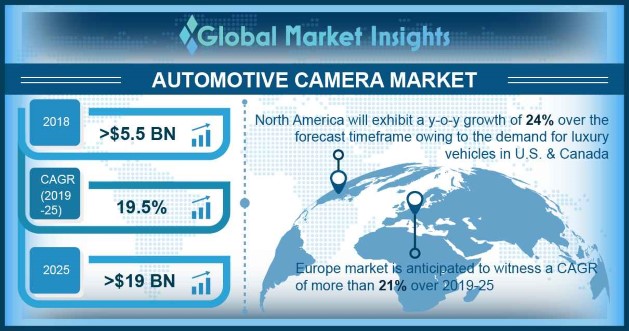North America automotive camera market to amass substantial proceeds over 2019-2025, increased vehicle safety norms to drive the product demand
Publisher : Fractovia | Published Date : 2019-05-28Request Sample
The automotive camera market has been gaining immense traction in recent years, with drivers creating a massive demand for hi-tech driving assistance equipment that can make vehicles safer for those on board as well for those outside the vehicle. At the 2019 New York International Auto Show, a slew of next-generation vehicles were put on display and most of them came fitted with in-car and exterior monitoring systems. While some of the cameras were used for blind spot monitoring, some were installed on the dashboard for facial recognition. Most cameras helped cars to see around them, helping the vehicles take another step towards an autonomous future while others improved vehicle security, safety and convenience by combating drunk driving through analysis of the driver's face and behavior.
Germany automotive camera market, by type, 2018 & 2025 (USD Million)

Google released an auto trends search data in 2018 which conclusively indicated that increasing number of motorists are looking for onboard cameras. Such a trend has inspired automotive industry leaders like BMW, Tesla, Kia and General Motors to position themselves to meet increased demand creating a positive growth outlook for the automotive camera market. Cameras are being positioned almost everywhere inside and outside vehicles to get an overall vision of the vehicle’s surroundings. For instance, the CT5 compact sedan designed by Cadillac that has been unveiled at the auto show has a camera on top of the steering column. The camera measures driver’s awareness and allows hands-free driving assistance that helps the car navigate on its own as long as the driver stays attentive on most U.S. highways.
2020 Hyundai Sonata was also unveiled at the auto show and showcased five cameras installed throughout the car. The cameras placed on the front, mounted on the mirrors and also at the rare work to provide an enhanced bird’s eye view of the vehicle’s exterior. Tesla cars are also equipped with internal and external cameras. The new 2019 X5 SUV by BMW comes with an optional driver monitoring camera that is mounted in the Extended Traffic Jam Assistant system in the digital dashboard of the car and makes sure the driver is paying attention to the road. As such cameras will evidently increase driver safety and convenience in vehicles, the demand for cameras is anticipated to expand soon and buyers of all vehicle types would demand such features in the cars, creating immense growth scope for the automotive camera industry.
According to the U.S. National Highway Traffic Safety Administration (NHTSA) 37,133 people died in 2017 due to motor vehicle crashes and most of these crashes can be attributed to human error. The NHTSA is therefore a strong advocate for the increased implementation of safety features on vehicles and is leaning towards the inclusion of newer and advanced technologies such as pedestrian automatic emergency braking, backup camera, lane assist and blind spot detection besides many others. Most of these technologies involve the use of cameras. For instance, a pedestrian automatic emergency braking system typically uses forward-looking cameras to detect and avoid collision by automatically applying the brakes if the system determines a pedestrian is in danger of being hit by a vehicle.
The rearview video system or the backup camera has possibly witnessed the strongest advocacy from the NHTSA as it helps prevent crashes and protects vulnerable people such as children, as they are almost impossible to detect while reversing a large vehicle. The support for making backup cameras on vehicles mandatory has been so strong that in 2014 the NHTSA announced that all vehicles sold in the U.S. after May 2018 should compulsorily be equipped with rearview camera system. The Trump administration has even tried to repeal the law but consumer awareness for the need of backup camera has already been raised and even if new vehicles are not equipped with backup cameras, the aftermarket demand for such equipment is quite strong indicating robust prospects for the automotive camera market.
The aforementioned information quite overtly indicates that North America is expected to be a major contender of the global automotive camera market, pertaining to the rising number of vehicle crashes in the U.S. and Canada and the subsequent implementation of stringent norms to reduce road accidents. Driven by the rise in the demand for luxury vehicles and the upsurge in the deployment of ADAS & safety systems in cars, the North America automotive camera industry size is expected to showcase a CAGR of 24% over 2019-2025.
The emergence of self-driving cars has also created a potential growth avenue for the automotive camera industry as most self-driving or autonomous vehicles “see” the world around them through a combination of sensors and cameras. In fact, Elon Musk recently opined that LiDAR, the laser-based scanning technology that most autonomous car initiatives rely on is replaceable by cameras and Cornell University researchers have backed up the claim. According to them, autonomous cars can now use a new method of forming a 3D of the world around them by using a pair of comparatively inexpensive cameras.
The present need of advanced safety features in vehicles and the future that will bring driver-less vehicles to the roads will both create a substantial scope for the automotive camera market that is expected to record double digit CAGR over 2019-2025.